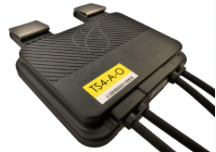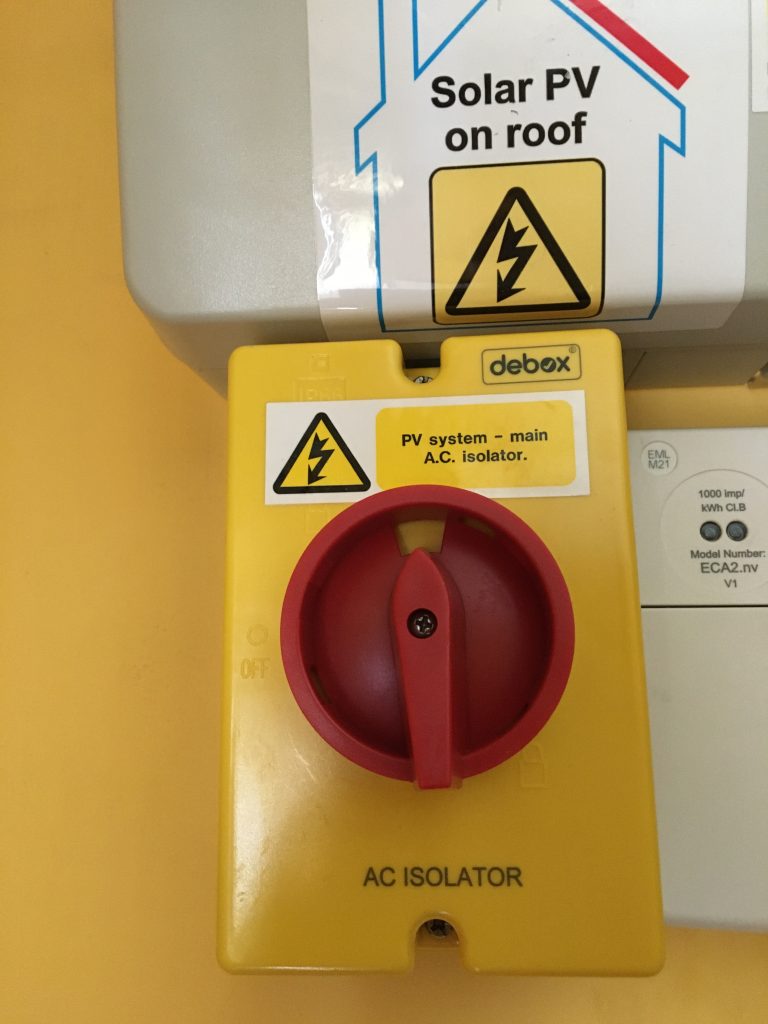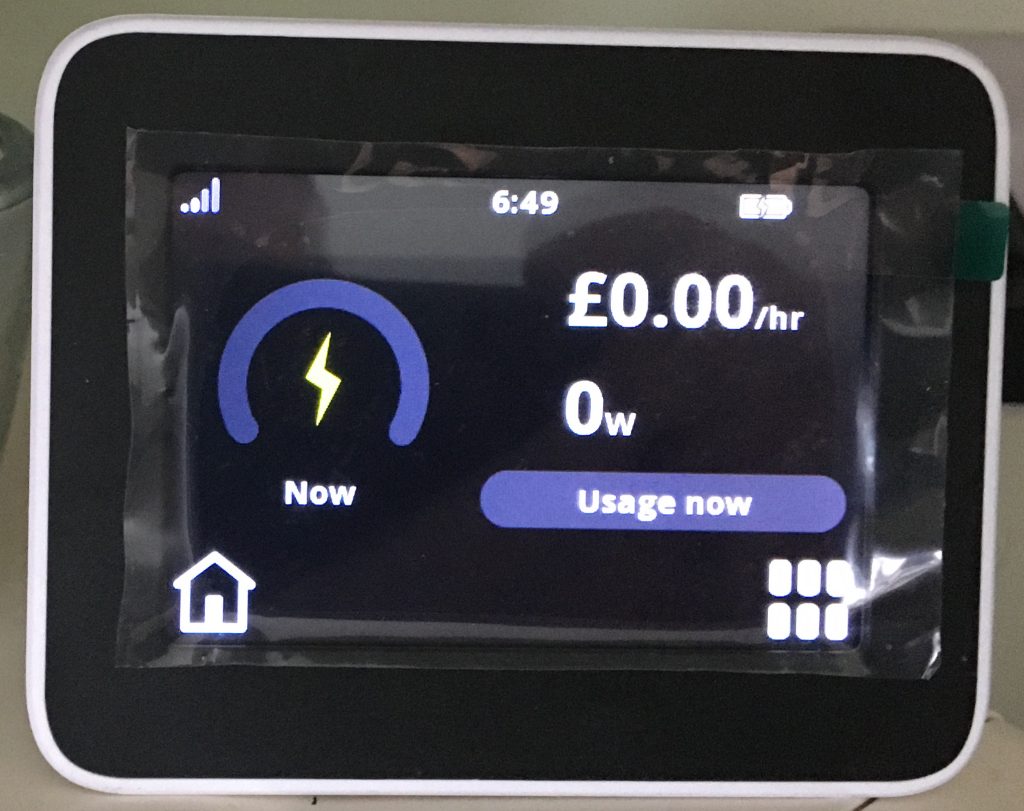‘Free’ electricity from the sun
Obtaining low-cost renewable solar energy has always had much appeal, but historically the investment costs has been rather off-putting, especially in the U.K. where it is perceived that the climate doesn’t provide a reliable enough amount of sunshine.
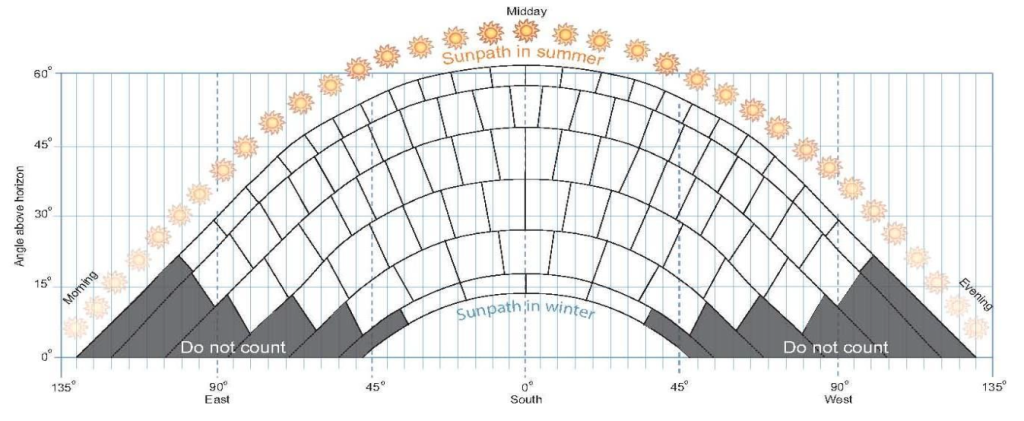
However, in recent years a number of things have changed this evaluation. Performance improvements in solar panels and associated power inverters have resulted gains in energy creation, coupled with the availability of modern battery arrays substantial enough to store the energy produced for later reuse. At the same time, shocks to world fuel prices have results in a rapid shorting of the ‘payback period’; once it was considered that a typical household solar installation would take in the order of 25 years to recoup the investments costs. This has tumbled to around an estimated 8 years based on calculations made last year, and taking into account the recent price increases for domestic electricity supply, the period could be approaching 4 years with further shortening likely as energy prices continue to rise. The recent removal of VAT by the UK government on the implementation of solar energy systems is an added boost.
One additional further benefit that has recently arisen is the introduction by some power utility companies, such as Octopus Energy, of ‘agile’ export tariffs, which pay increased amounts at peak demand times. This can be taken advantage of by the use of smart meters, supplying surplus generated or stored energy to the grid at the best times to maximise revenue, offsetting the purchase of electricity from the grid at other times.
Given that the future is anticipated to require increasing use of electricity to provide power for EV cars and hybrid vehicles, generating your own electricity makes increasing sense.
Overview of our implemented system

Given the now obvious benefits of a solar energy, we have acted accordingly and implemented a system, which has the following component parts:
- 13x 385W JA Solar Monocrystalline Panels with PERC technology, limited by the available roof space, but sufficient for energy needs.
- Alumero Mounting accessories & Tigo Optimisers to enhance performance when part of the solar array is shaded.
- Luxpower Hybrid Auto Inverter, 16A single phase, to convert the generated 12V DC electricity to 240V AC for household consumption or export.
- 4.8 kW Aoboet Uhome battery storage array to store excess energy for later use.
- AC and DC isolators to connect the component system parts.
- Generation meter to measure energy production.
- Wifi Monitoring portal for displaying instantaneous and historical performance.
The calculated annual yield for this system is 3,679kWh, which should be enough to fulfil the household’s electricity needs, estimated at 3,207kWh based on previous usage.
Solar Panels – the ‘heart’
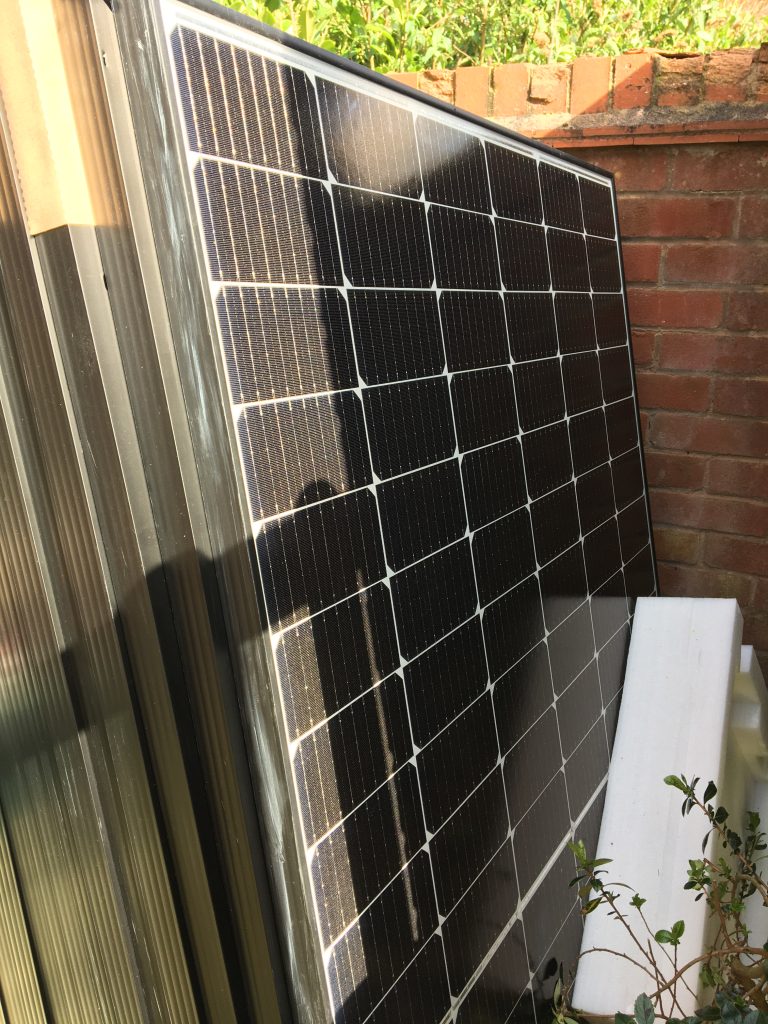
Key to the collection of energy from the sun are naturally the solar panels. These vary in size, and technology is improving continuously, so the latest available are more efficient than previous generations.
Those selected for this project were 13 x 385W JA Solar Monocrystalline Panels with latest PERC (Passivated Emitter and Rear Cell) technology. Monocrystalline are more expensive but more efficient, with a longer lifespan than other types available. PERC technology improves light capture near the rear surface, optimising electrons flow and thereby achieving higher efficiencies.
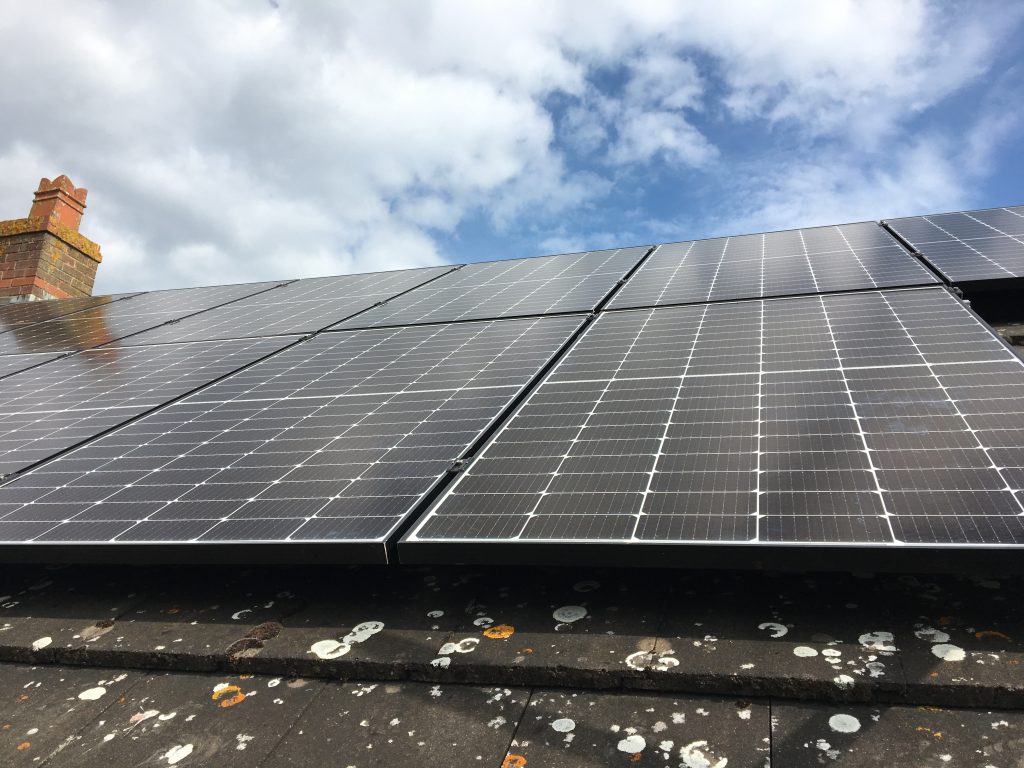
The amount produced by a solar array naturally depends on sunlight hours and will be much lower with poor weather or as daylight reduces, whilst household electricity demand also varies during the day.
The ultimate aim of using solar power is to reduce as far as practically possible the need to source energy from the grid. Consequently, a larger array of modules than those just to meet the typical usage amount is needed to ensure adequate production whatever the weather, with the excess being stored or exported.
Alumero mounting kits were used for fixing the solar panels to the property roof, together with Tigo optimisers which maximise the generation from each panel. Without such optimisation, the power output from all solar modules can be reduced when some of the array is in shade.
DC isolators connect two ‘strings’ of series connected panels to the Hybrid Inverter.
Hybrid Inverter – ‘the brains’
In order for the system to be truly useful, power conversion and energy management functions are needed, to ensure a seamless and uninterrupted supply of electricity from the available sources i.e. an appropriate mix of the local generation, storage and grid supply. Chosen for this installation was a Lux Hybrid Automated 16 Amp single phase inverter.

The Hybrid Inverter ensures that when solar energy is available i.e. during daylight hours, this is firstly routed to provide for domestic consumption, and then used to charge the battery storage (as required, if not full). Any additional energy is exported to the external grid. When there is not enough energy generation from the solar array, the hybrid inverter routes the energy storage to the household, and when this is depleted, electricity is imported from the grid in the usual way. Critically, where to source electricity from is completely seamless such that the domestic consumption is never interrupted and the household is unaware of these ‘decisions’ being made.
It’s the inverter’s job to take the DC electricity produced by the solar panels and turn it into 240V AC electricity for household use. It’s a sad fact that many domestic appliances then take this 240V AC and convert it back to DC and lower voltages like 12V and 5V; this double conversion adding theoretical inefficiencies. But this is simpler to implement than rewiring the entire building and trying to then integrate with power to and from the grid.
AC Isolators connect the Inverter’s output to the household electricity supply.
Batteries – ‘the memory’
Quite literally, ‘saving for a rainy day’ is the function of the batteries, which add to the capability and capacity of solar power generation. They are effectively ‘optional’ since the system can be run without them. But since there is a huge natural variation between maximum sunlight and night-time, it makes sense to capture excess energy at peak times, and use this when sunlight is not available or sufficient.
Chosen for this project were 2x Aoboet Uhome-LFP 2400 providing 4.8kW of storage capacity.
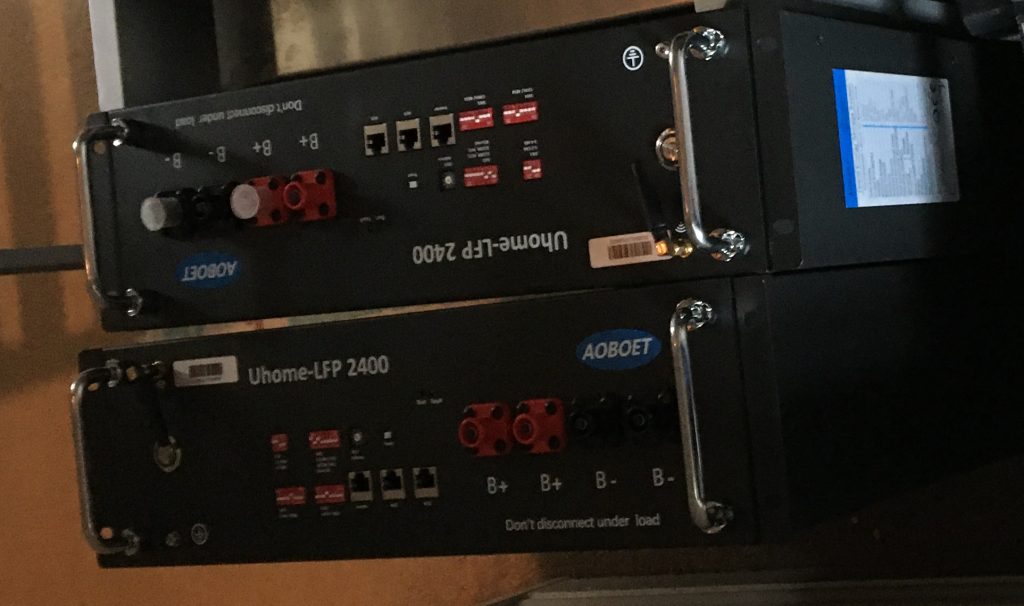
At the beginning of a day, the batteries are naturally somewhat depleted, and therefore excess solar energy is initially used to charge them. Once full, they remain ‘on standby’ until later when generation is unable to fulfil the immediate electricity needs, in which case they start discharging their stored energy. Ideally, they will not become completely depleted over the course of the day and night, so that energy is not needed to be imported from the grid.
Grid – import / export
Electricity from the grid is the “insurance” for times when the solar energy is not able to fulfil demand. Naturally, this is likely to be due to a lack of winter daylight hours and/or poor weather, which of course has to be paid for.
But at other times, there will be an excess of energy that can be exported to earn back some of these costs. A Generation Meter as part of the solar energy system enables this export of electricity.
The bi-directional energy flow is measured with a ‘smart’ meter using a suitable import / export tariff from the Utility company, such as the Octopus with their Agile tariff, and displayed on an associated WiFi monitor.
As to be expected, the amount paid by the Utility for kWh export is considerably less than that charged for import, so it’s worth making best use of the generated and stored energy as much as possible, like running appliances when the sun shines!
An EPS (Emergency Power Supply) socket was additionally included in this project. Though optional, it was chosen for providing ‘backup power’ from the solar energy system in the event of a power outage from the grid supply. It is standard practice in such an event to shut off the export to the grid from solar energy systems to avoid difficulties whilst restoration work is in progress. But during such a period, the household can make use of the generated and stored local energy, for a limited time and restricted to a maximum of 13A. Avoiding excessive consumption, it should be possible to maintain a local supply for 12 hours, assuming a fully charged battery array.
To complete the project to become an ‘energy generator’ (as well as satisfying own consumption needs), an MCS (Microgeneration Certificate Scheme) certificate is issued, together with receiving acceptance documentation from the DNO (District Network Operative). This then allows the establishment of the export tariff with the Utility provider so that payments for excess energy exported will be made.
Operating performance
A WiFi Portal provides the householder with an overview of the current operation of the solar energy system, displaying instantaneous status and historical energy performance for tracking generation yield and import / energy export.
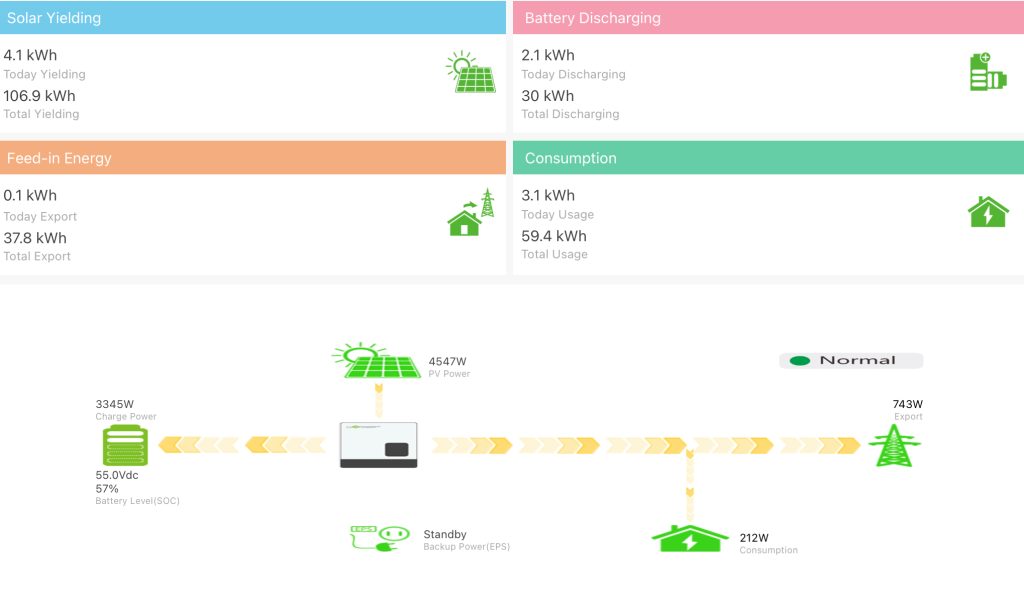
Initially, it can be reported that average energy yield is around 0.86kWh, ranging between a typical peak of 2-4kW during the day and zero at night, compared with average consumption of approximately 0.35kWh, with the excess charging the batteries in the morning and exporting to the grid during the rest of the day. During the night, the consumption is met from the battery storage, with the batteries depleted to around 11% by the next day. It is noted that even during relatively cloudy days, at least around 10% of the 5kWh maximum power is generated, enough to at least meet the immediate consumption needs and even provide some battery replenishment.
A complete picture of the operating performance of the solar energy system will be known after a full year, taking into account the peak of summer and the shortest winter daylight period. Rising costs of electricity will also impact on the longer-term cost savings anticipated.
Conclusions
Hopefully this ‘project description’ is of interest and perhaps of use to anyone contemplating installing a Solar Energy system at their home or office premises. Please feel free to get in touch if you would like us to provide consultancy advice (on a no-obligation FOC basis) leading to a quotation for establishing your own system, or just to gain an in-depth appraisal and more information from our first-hand experience of implementing a Solar Energy system.
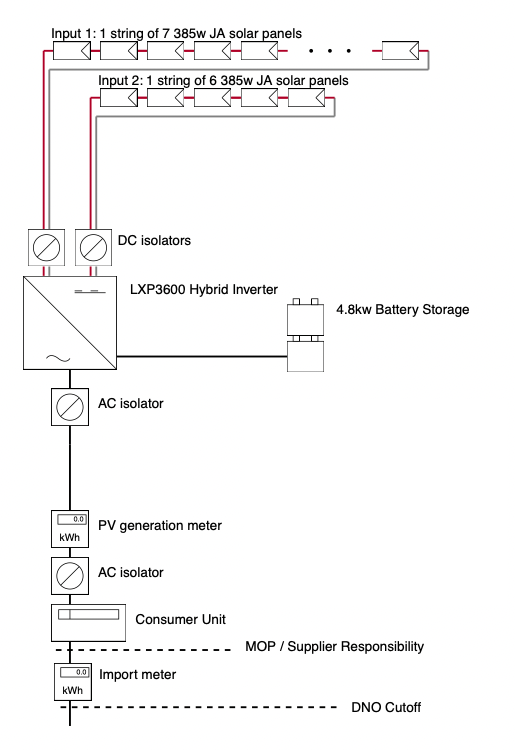
Our summary of conclusions at this stage having now implemented a system are:
- Solar energy collection has developed rapidly in recent years, particularly now that home energy storage is practical enough to capture excess energy during peak daylight and release it for use during the night or whenever demand exceeds generation.
- Although such systems are still a significant investment, given the recent escalation in energy costs, the ‘break-even’ point has reduced dramactically and the trend is for energy costs to continue to rise thereby making the payback period increasingly shorter.
- An attractive feature is the notion of being paid to supply energy to the grid, though it should be noted that currently at best this is 7.5p per kWh, so unlikely to be a significant revenue source. But it does mean that energy bills over the longer term will be vanishingly small.
- The contribution to the nation’s renewable energy mix helps in a small way to aid the drive to reduced carbon emissions and tackle climate change.
- Naturally, a suitable oriented roof or land space for solar panel installation is required, as well as a location for housing the inverter and batteries (loft space is ideal). Plus, it should be noted that a PV cable needs to be installed (most likely running down the outside wall of the building) to link the inverter to the consumer unit.
- Should power cuts from the grid occur in the future, the solar energy system is capable (thanks to the EPS socket) of providing power for a limited period to maintain household electricity use.
- With the increasing use of electric cars (all new will need to be at least hybrid by 2030), being able to source local renewable energy will make increasing sense.
@YellowsBestLtd our mission is in “Keeping Customers Operational”. We’re always keen to enhance our range of #business services, increase the #enterprise infrastructure we support and expand our mix of #sustainable solutions we offer for supply and maintenance of new and legacy #technologies and products for our customers.
Please help us understand what would be of interest to you by getting in touch to discuss your management services or solutions requirements, whether you’re implementing new systems or maintaining existing infrastructure networks to serve your operational business needs. We look forward to hearing from you.


